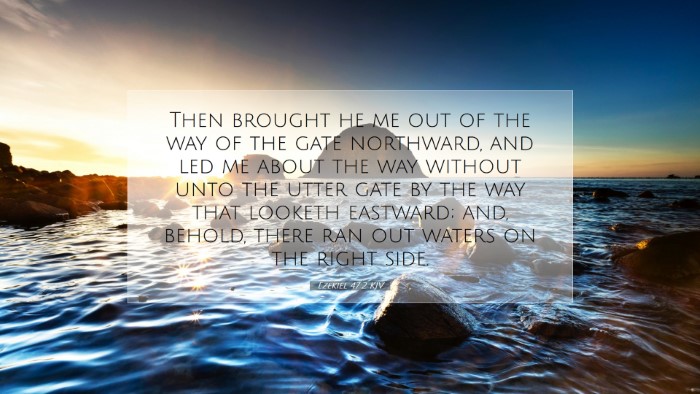Ezekiel 47:2 - A Commentary
Bible Verse: Ezekiel 47:2: "Then brought he me out of the way of the gate northward, and led me about the way without unto the utter gate by the way that looketh eastward; and, behold, there ran out waters on the right side."
Introduction
This verse is part of a prophetic vision experienced by Ezekiel, depicting the future restoration of Israel and the outpouring of God's blessings. The imagery of water is significant, representing life, healing, and the presence of the Holy Spirit. In this commentary, insights from notable public domain commentators such as Matthew Henry, Adam Clarke, and Albert Barnes will elucidate the meaning and implications of this verse.
Exegetical Insights
1. Contextual Background:
The book of Ezekiel is filled with vivid imagery and prophetic messages aimed at a nation in exile. The latter chapters concentrate on the vision of a restored temple and the renewal of Israel. In 47:1, Ezekiel sees a river flowing from the temple, a symbol of divine blessing that will transform the barren land into a fertile, life-giving area.
2. Water as Symbolism:
Matthew Henry highlights that water often symbolizes spiritual blessings in the Scriptures. Just as physical water is essential for life, the living water that flows from God refreshes and restores the soul. In this passage, the waters flowing from the temple signify the richness of God’s grace and the spiritual nourishment that will be freely available to His people.
Significance of Directions and Movement
Ezekiel’s movement along specific directions fosters a deeper understanding of God’s intentionality in His plans for restoration.
- Northern Gate: The northern gate could symbolize the entry point of destruction and judgment. However, as Ezekiel is led away from this gate and toward the east, it represents a new beginning and hope.
- The Utter Gate: Leading Ezekiel to the 'utter gate' signifies a complete revelation. Albert Barnes notes that this movement signifies a transition from a place of judgment to a place of blessing.
- Eastward Vision: The east represents a place of renewal – the direction from which light comes. This further emphasizes the illuminating presence of God that is about to transform and renew His people.
Theological Implications
1. The Nature of Divine Restoration:
Adam Clarke points out that the flowing waters indicate an extensive restoration that begins at the temple, illustrating that true renewal emanates from God Himself. This emphasizes that any transformation within the community starts from divine initiative.
2. The Symbolism of Life:
The waters represent not only life but also the cleansing power of Christ. As the river flows outwards, it brings life to what was once dead. This reinforces the New Testament imagery of Jesus as living water (John 4:10), providing spiritual sustenance to those who believe.
Conclusion
Ezekiel 47:2 invites readers to reflect on God's promises of restoration and the life-giving power that His presence brings. Pastors, theologians, and students can glean a wealth of knowledge regarding God's sovereign plan to rejuvenate His people. Through the prophetic imagery, we are reminded of the abundant grace available to all who seek Him.
This verse not only speaks to the context of ancient Israel but resonates with believers today, as we experience the transformative effects of the Holy Spirit in our lives. As we ponder on these waters flowing from the temple, may we approach our ministries with the understanding that God’s grace is sufficient to heal, restore, and enrich the parched places of our hearts and communities.


